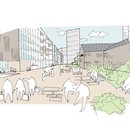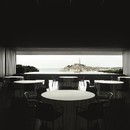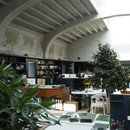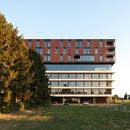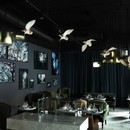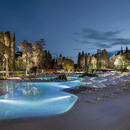Biografie
3LHD ist ein interdisziplinär ausgerichtetes Architekturbüro, das 1994 in Zagreb von den kroatischen Architekten Saša Begović (geboren 1967 in Bjelovar), Marko Dabrović (Dubrovnik, 1969), Tatjana Grozdanić Begović (Zagreb, 1968) und Silvije Novak (Rijeka, 1971) gegründet wurde.Zum Zeitpunkt der Gründung waren drei der vier Partner noch Studenten an der Fakultät für Architektur in Zagreb, in einer Zeit und Atmosphäre des politischen und wirtschaftlichen Übergangs des Landes (unabhängig 1991, in den nächsten zwei Jahren Mitglied der UNO und der EU).
Alle vier sind Absolventen der Fakultät für Architektur an der Universität Zagreb. Paula Kukuljica (Oakville, Kanada, 1976) gehört seit 2016 ebenfalls zum Büro.
Die Partner von 3LHD sind Gastprofessoren an Institutionen auf der ganzen Welt und derzeit Mitglieder der Fakultäten für Architektur der Universitäten Zagreb und Split.
Ziel des Büros ist es zahlreiche funktionale Aspekte in die eigenen Projekte zu integrieren, die vom Studium der Stadt- und Landschaftsgestaltung über die Grafik bis hin zu verschiedenen Kunstformen reichen.
Im Mittelpunkt steht die Gesellschaft mit ihren vielen Facetten im Hinblick auf sich ständig verändernde Verhaltens- und Lebensbedingungen.
3LHD ist verantwortlich für die Gestaltung zahlreicher öffentlicher Projekte, insbesondere in Kroatien, und ist bekannt für „seine Einfachheit und seinen zeitgenössischen visuellen Aspekt in der Architektur“.
Sein Ansatz hat zu einer Reihe von Projekten geführt, hauptsächlich in Kroatien, aber auch in anderen Ländern, darunter China.
International bekannt wurde 3LHD 2001 mit der preisgekrönten Erinnerungsbrücke in Rijeka (auf Kroatisch Most hrvatskih branitelja), einer futuristischen Fußgängerbrücke mit einer starken symbolischen Komponente, die kroatischen Veteranen gewidmet ist. Ein „Ort der Erinnerung und Frömmigkeit, aber auch der Begegnung und Sozialisation“.
Die Brücke besteht aus einer einzigen 150 Tonnen schweren Stahlkonstruktion, die in einer lokalen Werft hergestellt und auf einem speziell dafür entwickelten Lastkahn auf dem Seeweg transportiert wurde. Die Brücke ist in der Form eines "L" mit einem dünnen Blech als Steg (65 cm) gestaltet mit einem stark monumentalen vertikalen Endteil.
Auch der Bau der Villa Klara, ebenfalls 2001, aber vier Jahre vor der Erinnerungsbrücke, im 1997 konzipiert, ist auf große Resonanz und Anerkennung gestoßen. In einer natürlichen Umgebung an den Hängen des attraktiven Hügels von Cmrok gelegen, ist die Villa Klara ein Zuhause für eine Familie, die sich an ein besonders steiles Gelände anpasst, ohne die üblichen Unterteilungen Erdgeschoss/erster Stock und öffentlich/privat, aber aufgeteilt durch eine Reihe von Einheiten, die sich perfekt in die umgebende Landschaft integrieren.
3LHD architects hat an großen internationalen Ausstellungen teilgenommen, wie der Expo 2005 in Japan und der Expo 2008 in Saragossa, wo das kroatische Architekturbüro die Pavillons seiner eigenen Nation gebaut hat.
Im Jahr 2010 nahm es an der Ausstellung der Biennale Venedig teil, die Kroatien mit einem schwimmenden Pavillon mit starker visueller Wirkung vorstellte. Gebaut aus 32 Tonnen Stahlgewebe, haben 42 Schichten von Profilen ein Werk von 19x9x5,5 Metern geschaffen. Aus der Ferne erscheint die Struktur als kompaktes Volumen, nähert man sich und tritt ein, zeigt sie sich in ihrer leichten Zusammensetzung ohne wirkliche Konsistenz.
3LHD nahm auch an der Ausstellung „Mare Nostrum“ auf der zweiten Internationalen Biennale in Rotterdam (2007) und an der Gruppenausstellung „New trajectories: Contemporary Architecture in Croatia and Slovenia” in Boston und an der Harvard University (2008) teil.
Es wurden auch zahlreiche Beherbergungsbetriebe gebaut: vom Hotel Lone in Rovinj (2010) über die großen Renovierungen der Hotels Dubrovnik Palace (2014) und Adriatic in Rovinj (2015) bis hin zum jüngsten LN Garden Hotel in der südlichen Provinz Guangdong in China (2018).
Erwähnenswert sind auch die Riva Waterfront in Split, der Sports Hall Bale in Istrien, das Centre Zamet in Rijeka, das Zagreber Tanzzentrum in Zagreb.
Für ihre Arbeit erhielt 3LHD Architects wichtige internationale Auszeichnungen wie den Preis für das beste Gebäude in der Kategorie Sport beim ersten World Architecture Festival WAF 2008, den IOC/IAKS Bronze Medal Award 2009, den IOC/IAKS Silver Medal Award 2011, den AR Emerging Architecture Award (UK), den ID Magazine Award (USA) und den Croatian Professional Awards. Im Jahr 2012 zeichnete der kroatische Präsident Ivo Josipović 3LHD für seinen herausragenden Beitrag zur zeitgenössischen Architektur in Kroatien und im Ausland aus.
3LHD architects: Berühmte Werke und Projekte
- Grand Park Hotel, Rovigno (Croazia), 2019
- Hotel LN Garden, Canton (Cina), 2018
- Stadio e Centro sportivo e ricreativo, Đurđevac (Croazia) 2018
- Complesso residenziale Blok Bužanova, Zagabria (Croazia), 2018
- ResoLution Signature Restaurant, Rovigno (Croazia), 2017
- ACI Marina, Rovigno (Croazia), 2016
- Ristrutturazione Hotel Adriatic, Rovigno (Croazia) 2015
- Ristrutturazione Hotel Dubrovnik Palace, Dubrovnik (Croazia) 2014
- Amarin Holiday Apartments, Rovigno (Croazia), 2013
- Lone Outdoor Pool, Rovigno (Croazia), 2013
- Park Muzil, Pola (Croazia), 2011
- Hotel Lone, Rovigno (Croazia), 2010
- Ski Restaurant Raduša, Gornji Vakuf-Uskoplje (Bosnia-Erzegovina), 2011
- Port Lands Sports Centre, Toronto (Canada), 2010
- Green Pavilion Restaurant, Zagabria (Croazia), 2010 - in corso
- Zamet Centre, Fiume (Croazia), 2009
- Zagreb Dance Centre, Zagabria (Croazia), 2009
- Spaladium Arena, Spalato (Croazia), 2009
- Sv Vid Housing, Rovigno (Croazia), 2008
- Sports Hall Bale, Bale (Croazia), 2007
- Kozala Square and Service Building, Fiume (Croazia), 2007
- Riva Split Waterfront, Spalato (Croazia), 2007
- House J2, Zagabria (Croazia), 2007
- Bus Terminal Žabica, Fiume (Croazia), 2005
- Croatian Pavilion EXPO 2005, Aichi (Cina), 2005
- Villa Klara, Zagabria (Croazia), 2001
- Memorial Bridge, Fiume (Croazia), 2001
Offizielle Webseite
www.3lhd.com
Interview
The young studio 3LHD architects talks about the interaction between regional architecture and contemporary movements in worldwide architecture and how it effected 3LHD main projects.Interview by Flores Zanchi
We don’t think that styles are so important nowadays. Still, in the last 20 years, we can say that group of new contemporary Croatian architects emerges on our architectural scene with some of the most important realizations mainly in the public sector and housing. Participation of those emerging architects in lecturing on international universities, in competitions and publications, receiving international awards and recognitions are best proof of its quality and recognizable specificities. Maybe, it’s worth mentioning that very strong modernist tradition is always a source of inspiration as well as local regional architecture and of course being up to date with contemporary movements in world architecture.
2 - Recently 3LHD architects have completed the Hotel Lone located in Monte Mulini forest park, one of the most attractive tourist area of Croatia. Would you tell us something about the building? Which are its features?
Hotel Lone is the first design hotel in Croatia, situated in Rovinj’s most attractive tourist zone, in a unique and protected region of the Monte Mulini forest. The hotel has 236 rooms and 12 suites, 16 rooms offer an exclusive experience of a private massage pool built in the room's terrace. There are three hotel restaurants, two bars, a jazz club and a mini club. One of the characteristics of the hotel is a high-quality conference center as well as a Mediterranean-inspired wellness spa.
The hotel was designed taught by the experience and the highly successful collaboration of Croatian architects, product designers and artists from the 1970s generation, this time by a team of new generation Croatian creatives comprised of architects, conceptual artists, product, fashion and graphic designers. This was a great opportunity to promote worldwide Croatian creativity, especially since all designers and artist involved in the project are already internationally recognized.
In addition to the overall architecture, the interiors and the furniture were designed and chosen especially for the hotel in order to achieve a distinct and recognizable identity. The designers from Numen / For Use designed the furniture. The fashion studio I-GLE designed the staff uniforms and other textiles. Artist Silvio Vujičić created graphics on fabrics for the rooms. Installations in the hotel lobby were made by a group of innovative artists: Ivana Franke - "Room for running ghosts"; Silvio Vujičić - "In the hanging garden no one speaks" and the fashion studio I-GLE - textile compositions No1, No2, No3. Studio92 designed the Wellness & Spa center, while Studio Kappo did Landscape design. The agency Bruketa & Žinić OM conceived and oversaw the visual identity of the hotel.
The site's complex terrain determined the specific Y shaped ground plan which enabled a functional organizational scheme; quality views from all rooms and the grouping of public facilities around a vertical lobby that connects common spaces on all levels, creating a central volume of impressive height and scale where all vital functions of the hotel take place. Surrounding ambiance is the hotel’s signature visual element which also defined all views of the interior. The ambient light and Mediterranean greenery reflects on the glossy surfaces of ceilings in public areas and on the mirrored panels on the walls in the rooms, pulling them deeply into the interior and intensifying the effect of the surrounding plants.
3 - One of your on board project is the Green Pavillion Restaurant in Zagreb. The idea behind the project brings out the high quality of the existing vegetation. Can you describe in detail what the project is about?
This is actually the project for Canteen of Agriculture and Forestry University in Zagreb. The most important element and the inspiration for this project is the location itself, with extremely high quality existing vegetation, which is densely distributed throughout the plot and gradually diluted out toward the eastern edge. The idea of the new Pavilion / Restaurant is to construct a space by mapping the area of high quality trees and to define the remaining territory for construction. By raising this "cut" green territory in the air the space “below” is created. The basic formal and functional element and a seasonal regulator of light is so-called “vegetative” canopy that has been formed along the entire roof edge around the whole building.
The large entrance atrium is the main entrance Plaza, a meeting place, an open terrace and a main entrance to all building spaces. Two main restaurants (canteen and a’la carte) are located next to two main building atriums. The canteen space is oriented to the Forest Park and the sliding doors enable its expansion to the outside environment. The Students association offices and the multifunctional Hall are part of the eastern volume, thus allowing the pavilion to be built in phases.
The small temporary buildings and greenhouses that have always been present throughout the campus as part of the faculty culture have served as inspiration for the accommodation units with ten apartments which have been incorporated into the project concept. The apartments are designed as freestanding volumes raised up on the roof for privacy. Zones with different plants which may also serve educational purposes were formed around the apartments, on the roof surface.
The idea is to create a sustainable house, which will contribute to the environment in every respect - with building materials, construction and structure. In designing, a special significance is given to natural lighting and natural space ventilation, which further reduces the energy requirements for artificial lighting, heating and cooling. The roof and its oversized vegetative canopy are excellent regulators of heat, a thick protective cover that keeps the house from cold in winter and heat in summer.
4 - 3LHD is a collaborative architectural studio which guests several collaborators from different fields and backgrounds. How do you manage the team work and which are the features of working in a collaborative atmosphere?
The most important thing in our practice is a team work. From a beginning we were working as a 4 equal partners. Now when office has 25 people, we are forming different creative teams depending on the projects and always bringing in creatives from different disciplines to contribute to the main idea. Negotiation, tolerance and low ego must be the main recipe to success in a team work. Creating good atmosphere for every project is essential, and people are much more important than ideas. Great ideas will always occur in this kind of creative and dynamic environment. Most of our projects, Memorial Bridge, Croatian Pavilions on EXPO in Japan/Spain, Riva Split Waterfront, Zamet Centre, Zagreb Dance Centre and finally Lone Hotel, include a large number of creative collaborators, people of different professions, areas of activity and affinity, construction engineers, light specialist, product, fashion and graphic designers, artists.
5 - What projects is 3LHD working on at this moment? Could you please tell us a bit about your current activity?
After the successful completion and opening of the hotel Lone, 3LHD is still working on projects in Rovinj, which include reconstruction of existing hotels in Monte Mulini zone and a new project of Tourist Apartments Resort Amarin.
Current project list also includes a bus terminal Zabica soon to be built in Rijeka, a residential project 4 Towers and Business Centre Miramare, both in Zagreb, as well as already mentioned Green Pavilion Restaurant, a competition project we won last year.
Another large project currently on board is a project for Toronto Port Lands Sports Centre in Canada, ice arena for 4 hockey fields at the site of the old harbour area. The project is very specific since it has a vertical structure in which hockey rinks are located one above the other. Currently the project is on hold.
Aljosa Brajdic
Sandro Lendler
Damir Fabijanic
Domagoj Blazevic
Cat Vinton
Verwandte Artikel: 3LHD: Sasa Begovic, Marko Dabrovic, Tatjana Grozdanic Begovic, Silvije Novak, Paula Kukuljica
Verwandte Artikel: Studio 3LHD
Verwandte Artikel







